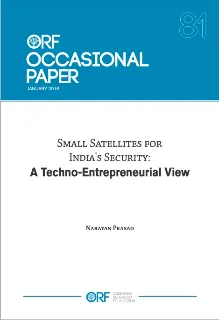The Terrain
The terrain of space exploration in Low Earth Orbit (LEO) has been continuously evolving and one can argue that small satellites have tremendously changed this terrain over the last three decades. The ongoing debates–small vs. large satellites, the size that constitutes ‘small’–are not related to capability or capacity, but rather their ability to complement each other’s platforms and overcome disadvantages.
This paper examines the continuously evolving technology and applications of small satellites of the class of <150kg. These small satellites are often missions with a two- to five-year timeframe. This study probes the potential of extending small satellite technology to space security through a study of adaptation and experimentation by stakeholders in the industry.
Small satellites provide strategic users with affordable satellite constellations that have excellent tactical and theatre control capabilities designed for specific operations. Some of the key advantages of using small satellites include the following:
• Unlike large satellites, small satellites can operationalise usage with minimal personnel and logistics tail. This advantage is due to their speciec design for tactical warfare: in mission scenarios, they act as
‘gap fillers’ for their larger counterparts.
• Larger satellites often have mission durations of over five years, inherently shortening their shelf life due to rapid technological changes on space-based platforms. Small satellites provide an excellent opportunity to take advantage of the constantly upgrading technologies to provide complementary technology capabilities.
• Small satellites offer a unique opportunity to integrate satellites at low cost per unit due to a combination of factors, such as using Commercial Off The Shelf (COTS) components along with simpler design philosophies due to their operational lives being internationally kept lower (to cope with constant cost/technology upgrades.)
• Small satellites provide augmentation and reconstitution at extremely rapid timelines. These are inherent advantages due to their rapidly design-build, short-notice deployment responsiveness. Low-flying constellations also provide graceful degradation.
• They provide an opportunity to task from theatre and in a constellation, their configuration can provide persistent and globally available capabilities. Small satellites, especially in constellations, have extremely low volumes per unit, considering their larger counterparts. Thus they other excellent survivability against Anti-Satellite (ASAT) engagement. The cost ratio in engagement of such constellations may often not favour the engager (provided the ability to be operationally responsive).
Applications of Small Satellites
The possibilities of hosting ser vices for Command, Control, Communications, Computers, Intelligence, Information, Surveillance, and Reconnaissance (C4I2SR) based on small satellites have substantially increased with the miniaturisation of payloads. ere are now a host of applications enabled by small satellites (particularly in swarms) that can transform the usage of the nal frontier for intelligence gathering and tactical use.
The small bouquet of applications mentioned in this section includes examples of current mission scenarios that are being used by several leading spacefaring countries to eectively use small satellite technologies in C4I2SR. It is important for India to have a roadmap in eectively testing some of these technologies within the country and in deploying them in operational usage at the grassroots level for eective ground utilisation of advanced technologies.
Electro Magnetic Emissions: One of the unique Electronic Intelligence (ELINT) operational programmes that are possible on small satellites is to map and characterise electromagnetic emissions (such as radars) around the world. Electromagnetic emissions such as ground radars are typically used by defence establishments for tracking airspace activity. Space-based mapping of the ground radars should provide an opportunity to develop airspace tracking hotspot databases used for electronic warfare that can be key to detecting and monitoring activities during tactical operations.
Imaging: Imaging satellites have taken a giant leap with the miniaturisation of technology and emergence of reliable low-cost electronics for space systems. ere is huge potential for using small satellites to complement the traditional legacy imaging platforms of the Indian Space Research Organsiation (ISRO) such as the CARTOSAT series of satellites. is should ll the gaps in latency and cover particular areas of interest with a frequent revisit.
Read the full report here.
The views expressed above belong to the author(s). ORF research and analyses now available on Telegram! Click here to access our curated content — blogs, longforms and interviews.

 PDF Download
PDF Download



 PREV
PREV


